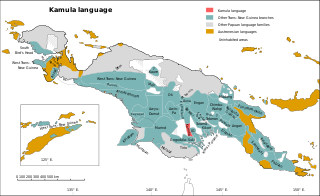The Yalë language, also known as Yadë, Nagatman, or Nagatiman, is spoken in northwestern Papua New Guinea. It may be related to the Kwomtari languages, but Palmer (2018) classifies it as a language isolate.
The Busa language, also known as Odiai (Uriai), is spoken in three hamlets of northwestern Papua New Guinea. There were 244 speakers at the time of the 2000 census. One of the hamlets where Busa is spoken is Busa in Rawei ward, Green River Rural LLG, Sandaun Province.

Abom is a nearly extinct language spoken in the Western Province of Papua New Guinea. According to a 2002 census, only 15 people still speak this language. All of the speakers are older adults. Middle-aged adults have some understanding of it, but no children speak or understand Abom.
The Ari language is a Papuan language of the Trans–New Guinea family. According to the 2000 census, there were only 50 Ari speakers, living in the two villages of Ari and Serea in Gogodala Rural LLG.

The Gogodala–Suki or Suki – Aramia River languages are a small language family of Papua New Guinea, spoken in the region of the Aramia River.
Kaki Ae, or Tate, is a language with about 500 speakers, half the ethnic population, near Kerema, in Papua New Guinea. It was previously known by the foreign designation Raeta Tati.
Awtuw (Autu), also known as Kamnum, is spoken in Sandaun Province, Papua New Guinea. It is a polysynthetic language closely related to Karawa and Pouye. It is spoken in Galkutua, Gutaiya, Kamnom, Tubum, and Wiup villages in Kamnom East ward, East Wapei Rural LLG, Sandaun Province.

Kamula is a Trans–New Guinea language that is unclassified within that family in the classification of Malcolm Ross (2005). Noting insufficient evidence, Pawley and Hammarström (2018) leave it as unclassified.
Barem (Brem), also known as Bunabun, is a Papuan language of Sumgilbar Rural LLG, Madang Province, Papua New Guinea.
Tirio is Papuan language of Western Province, Papua New Guinea. The Giribam 'dialect' may be a distinct language.
Namia is a Sepik language spoken in Namea Rural LLG, Sandaun Province, Papua New Guinea. It goes by various names, such as Edawapi, Lujere, Yellow River. Language use is "vigorous" (Ethnologue).
Beli is a Torricelli language of Papua New Guinea. It is also known as Akuwagel, Makarim, Mukili.
Yessan-Mayo is a Papuan language spoken by 2000 people in Papua New Guinea. It is spoken in Maio and Yessan villages of Yessan ward, Ambunti Rural LLG, East Sepik Province.
Baramu is a Papuan language of Western Province, Papua New Guinea.
Foia Foia (Foyafoya), or Minanibai, is a Papuan language of Papua New Guinea, spoken in an area near Omati River mouth in Ikobi Kairi and Goaribari Census districts.
Hoia Hoia (Hoyahoya) is a Papuan language of Papua New Guinea. It is close to Minanibai. The two varieties, Ukusi-Koparamio Hoia Hoia and Matakaia Hoia Hoia, are distinct languages, though significantly closer to each other than to other Inland Gulf languages.
Waboda is a Papuan language of southern Papua New Guinea. In Kiwai Rural LLG, it is spoken in Dameratamu, Gesoa, Kabaturi, Maduduo, Meipani, Sagero, Tirere, and Wapi villages.
Dibiyasoa.k.a.Bainapi is a Papuan language of Western Province, Papua New Guinea.
Abuʼ, also known as Ua, is an Arapesh language of Papua New Guinea. It is dying, as speakers are shifting to Tok Pisin.

Bamu Rural LLG is a local-level government (LLG) of Western Province, Papua New Guinea. The Kamula language is spoken in the LLG, near the Wawoi Falls area.




